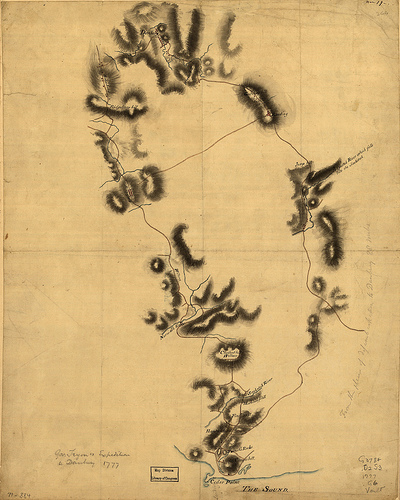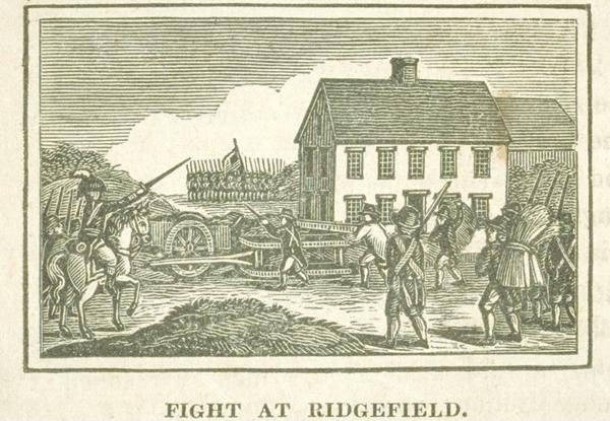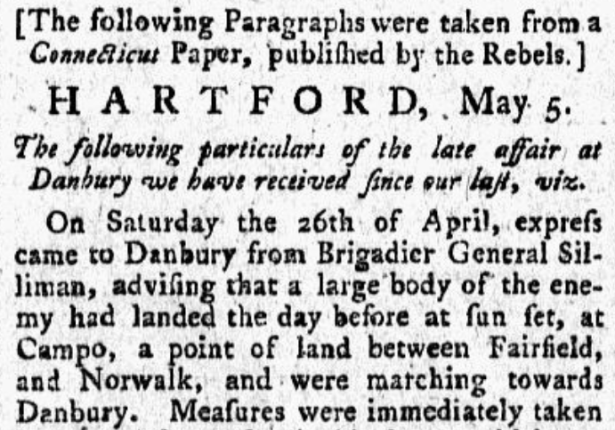By Richard Buel
When General George Washington ordered that Danbury serve as a supply depot for the Continental army in early 1777, he based his decision on the town’s importance as a regional trading and manufacturing center, served by several major roads. Protecting the army’s supplies was a militia regiment of 100 men under Colonel Jedediah Huntington and a militia company of 50 men under the command of Colonel Joseph P. Cooke.
Located some 25 miles inland from Long Island Sound, Danbury was considered beyond easy reach of the British, who, in August 1776, captured and occupied Long Island and New York City. Yet, on April 26, 1777, Danbury was attacked by roughly 1,850 men under the leadership of Major General William Tryon.
The British Raid Danbury

Governor Tryon’s Expedition to Danbury, 1777 – University of Connecticut Libraries’, Map and Geographic Information Center (MAGIC). Used through Public Domain.
Under the command of Captain Henry Duncan, British ships delivered 1,500 British regulars and American Loyalists to Compo Beach (in modern-day Westport) at 5 p.m. on April 25, 1777. A light rain fell as the soldiers carried their supplies ashore and, before midnight, began their march to Danbury on the Redding Road (today’s Connecticut Route 58). Sighted by patriots who then sent messengers to spread the alarm, the soldiers met with only light resistance. At midday they halted and rested at Redding, then continued on to Danbury, arriving 24 hours after their landing.
Many townspeople left Danbury in advance of the British. Doctor Isaac Foster, in charge of the Continental army’s medical supplies, moved them to New Milford. The 150 men under Huntington and Cooke, busily removing what supplies remained, soon retreated, and the British soldiers commenced their raid.
The British did not have wagons to remove the supplies, however, and they knew militia units were gathering to attack so they ordered the supplies destroyed. They removed supplies from the Anglican church building and set them afire in the street and torched twenty-two storehouses as well. The British spared the houses of Loyalists, however.
As a result of the raid, the Continental army lost a valuable cache of military stores. The official report, issued in 1777 by the commander in chief of the British forces, General Sir William Howe, itemized the losses:
A quantity of ordnance stores, with iron, etc.; 4000 barrels of beef and port; 1000 barrels of flour; 100 large tierces of biscuit; 89 barrels of rice; 120 puncheons of rum; several large stores of wheat, oats, and Indian corn, in bulk, the quantity thereof could not possibly be ascertained; 30 pipes of wine; 100 hogsheads of sugar; 50 ditto of molasses; 20 casks of coffee; 15 large casks filled with medicines of all kinds; 10 barrels of saltpeter; 1020 tents and marquees; a number of iron boilers; a large quantity of hospital bedding; engineers’, pioneers’, and carpenters’ tools; a printing-press complete; tar, tallow, etc.; 5000 pairs of shoes and stockings. At a mill between Ridgebury and Ridgefield, 100 barrels of flour and a quantity of Indian corn.
The Battle of Ridgefield
Brigadier General Gold Selleck Silliman, the commanding militia general in nearby Fairfield, learned of the British invasion almost immediately, but failed to assemble enough men to move forward before early the next morning. By the time his forces arrived at Redding, where he joined Connecticut’s militia leader Major General David Wooster and Brigadier General Benedict Arnold, the British column was well on its way to Danbury.

Fight at Ridgefield – Connecticut Museum of Culture and History. Used through Public Domain.
Silliman, Wooster, and Arnold pursued Tryon as far as Bethel, where they divided the 500 men they had collected. Wooster continued in pursuit with 200 men, intending to press the enemy’s rear, while Silliman and Arnold tried to block the invaders’ retreat to the coast.
After destroying the Continental army’s supplies and setting fire to both supply houses and private homes, the British forces marched toward Ridgefield and the safety of their ships. Wooster attacked Tryon’s rear guard and was mortally wounded but managed to ensure the British retreated along the Ridgefield Road, where Arnold identified a natural strong point he hastily fortified. There the American force, now numbering 400, inflicted heavy casualties on the British but eventually fell back.
The British, who bivouacked that night a mile beyond Ridgefield, expected to face a larger force blocking their retreat the next day, but getting a dispersed militia to collect was a problem for the Continentals. Arnold knew they needed an easily defended rendezvous point, so he stationed a battery of Continental artillery on top of a hill commanding a bridge that spanned a stream on the road to Compo Beach. When the British column came into view, Arnold had a larger force at his disposal than on the previous day, but the British forded the stream above the bridge and bypassed the Americans’ strong point. Arnold had to settle for harassing the British column from the rear as they made their way back to their fleet at the end of their third day in Connecticut.
Richard Buel is Professor of History Emeritus at Wesleyan University.









